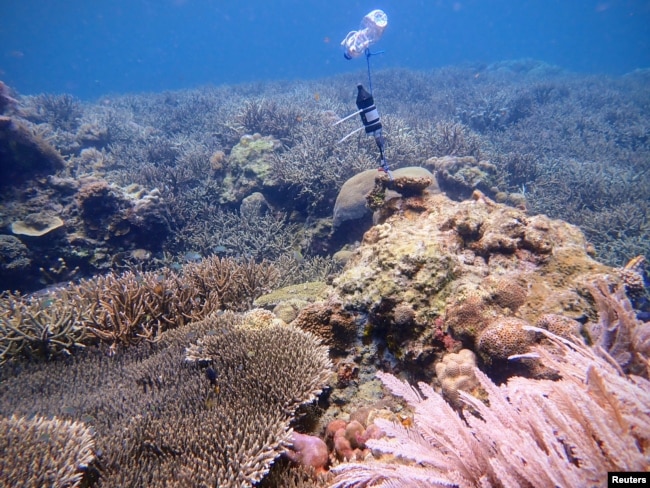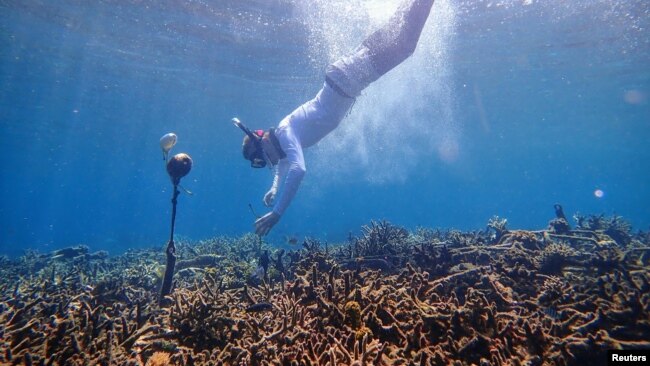海底面積の1パーセントにも満たないサンゴ礁。
それが何と!ウミガメ、魚、ロブスターなど、海洋生物の25パーセント以上を支えているというのですから・・・・感動と驚きです!!
VOAで英語を学びましょう!!
サンゴの声が聴きたい!!
サンゴの声を聞いてその健康状態を探る(和訳)
Scientists Listen to Coral to Learn About Its Health
June 09, 2022
人工知能、AI、を使って、サンゴが出す水中音を研究し、海の生き物についてもっと知ろうという国際科学者チームがいます。
サンゴは非常に小さな動物で、暖かい海水の中でサンゴ礁と呼ばれる巨大な岩のような構造物をつくります。
研究チームは、インドネシア中央部の島々で録音された水中音を聞きながら研究を進めました。
その結果、サンゴ礁は多くの音を出し、動物や植物がたくさん生息していることがわかりました。英国とインドネシアの大学の研究者たちは、先月、この研究成果をEcological Indicatorsに発表しました。⬇️
研究者たちは、何百もの音を録音し、それを聞くことでサンゴ礁の健全性を追跡するコンピュータープログラムを訓練しました。
健康なサンゴ礁は、”パチパチとキャンプファイヤーのような”複雑な音を発しています。それは、その上や中に住むすべての生き物のためです。チームの主任研究員であるベン・ウィリアムズは、不健康なサンゴ礁は荒涼とした音になると述べています。
AIシステムは、録音された音の周波数や大きさなどのデータを収集します。その情報から、AIシステムは約92%の確率でサンゴ礁が健全か不健全かを見抜くことができると言います。
科学者たちは、このAIシステムが、世界中の保護団体がサンゴ礁の健康状態を追跡するのに役立つことを期待しています。
また、オーストラリア、メキシコ、ヴァージン諸島のサンゴ礁から水中録音を収集し、サンゴを再建するプロジェクトの進捗状況を把握するのに役立てたいと期待しています。
科学者によると、サンゴ礁は炭素ガスの排出によってダメージを受けているとのことです。熱を奪う炭素ガスが、10年ごとに0.13度ずつ海面を温めていて、また海の酸性度は工業化時代に入ってから30%上昇しているとも言っています。国連が支援するグローバル・サンゴ礁モニタリング・ネットワークは、2009年から2018年の間に世界中のサンゴの14%が失われた言います。
サンゴ礁の面積は海底の1パーセントにも満たないのです。しかし、ウミガメや魚、ロブスターなど、海洋生物の25パーセント以上を支えています。サンゴ礁は、漁業にとって非常に重要な存在なのです。
Scientists Listen to Coral to Learn About Its Health
An international team of scientists is using artificial intelligence, or AI, to study the underwater sounds made by coral to learn more about the sea creatures.
Coral are very small animals that create huge rock-like structures, called reefs, in warm seawater.
The team of scientists listened to underwater sound recordings taken off islands in central Indonesia to learn.
They found coral reefs make many sounds and are full of animal and plant life. Scientists from British and Indonesian universities published their findings last month in Ecological Indicators.
The researchers used hundreds of sound recordings to train a computer program to track the health of a coral reef by listening to it.
A healthy reef has a complex "crackling, campfire-like" sound. That is because of all the creatures living on and in it. The team's lead researcher, Ben Williams, said an unhealthy reef sounds desolate.
The AI system gathers data like the frequency and loudness of sounds in the recordings. From that information, the AI system can find out about 92 percent of the time whether a reef is healthy or unhealthy, the study said.
The scientists hope the AI system will help conservation groups around the world track the health of coral reefs.
The researchers also hope to collect underwater recordings from reefs in Australia, Mexico and the Virgin Islands to help track the progress of projects to rebuild coral.
Scientists say coral reefs are being damaged by carbon gas emissions. They say heat-trapping carbon gasses are warming ocean surfaces by .13 degrees every 10 years. They also say ocean acidity has increased 30 percent since the beginning of the industrial era. The Global Coral Reef Monitoring Network, a United Nations supported group, says 14 percent of coral around the world was lost between 2009 and 2018.
Coral reefs cover less than 1 percent of the ocean floor. But they support more than 25 percent of marine life, including turtles, fish and lobster. Coral reefs are very important to the fishing industry.
Words in This Story
track— v. to follow something to find out more about it
crackling –n. a series of short, sharp noises
desolate — n. lacking people, plants or animals
frequency — n. the number of times a sound or radio wave is repeated in a period of time
conservation— n. the protection of animals, plants and natural resources
era — n. a period of time that is linked to a particular event

